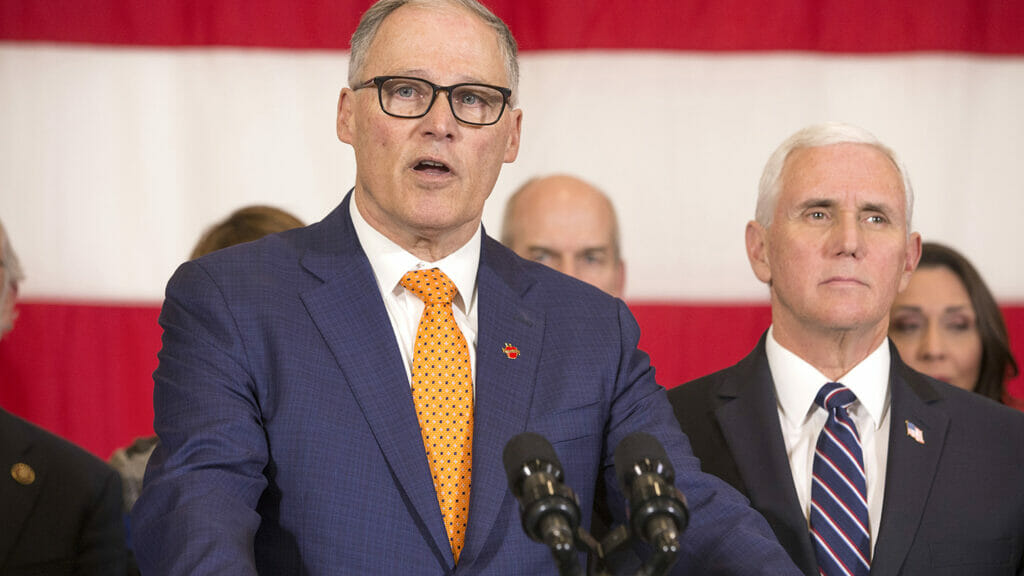
After state officials had delayed implementation of the nation’s first long-term care payroll tax, lawmakers this winter failed to defeat it permanently.
Deductions used to fund the WA Cares long-term services and support trust are expected to resume in July. House Bill 1011 would have repealed the program, which requires all adult workers in Washington to pay a tax of 58 cents for every $100 — or $290 annually on a $50,000 salary — unless they have private long-term care insurance. The repeal proposal, backed by 31 state lawmakers, didn’t receive a hearing in the House.
The Association of Washington Business had sent a letter in February to Gov. Jay Inslee (D), pictured, and legislative leaders calling the WA Cares program “unclear” and “insolvent.” The program was first instituted in 2019, with funds meant to reimburse nursing home care and other services. To be eligible for benefits, an employee must have contributed to the fund for 10 years without an interruption of five or more consecutive years; contributed three of the last six years; and worked at least 500 hours per year.
EAST
State threatens rate cut for low occupancy
CONNECTICUT — New legislation threatens to lower administrative payments to any of the state’s 200 nursing homes that cannot maintain 90% occupancy, even as the national skilled nursing average hovers around 75%.
State officials in late February acknowledged the effort is an attempt to address what they consider overbedding, and it comes as skilled nursing providers are intentionally keeping some beds offline due to lack of adequate staff.
Matthew Barrett, president and CEO of the Connecticut Association of Health Care Facilities, estimated the “excessively punitive” bill would reduce Medicaid rates by $3.50 per patient per day and ding up to three-fourths of providers. The latest cut, proposed by the Department of Social Services, would be made in addition to an existing Medicaid reduction meted out to providers with 10% of their beds unfilled.
“In this sense, the policy to additionally reduce the administrative and general components of the rates is a doubling of a penalty that is already cutting the rates under current rules,” Barrett said.
DSS Commissioner Andrea Barton-Reeves said the intention of the new rule was to move providers to either fill the beds or reduce their licenses.
Barrett told McKnight’s that nursing homes have traditionally outpaced national occupancy levels, with occupancy approaching 89% just prior to the pandemic.
Mag Morelli, president of LeadingAge Connecticut, asked the state to recognize the impact of workforce issues and exempt nursing homes that demonstrate a demand they cannot meet due to lack of staffing.
Permanent closures loom, advocates warn
NEW YORK — Labor and management are in lockstep that a 5% Medicaid reimbursement increase proposed by Gov. Kathy Hochul (D) will not do nearly enough to alleviate the pressures nursing homes are facing.
“I truly believe that we will very soon face the very difficult but real decision on permanent bed closures in this community and all the things that go along with that, including layoffs,” said John Murray, chief financial officer of Syracuse-based Loretto, a group of affiliated nonprofits with than 900 nursing home beds and 70% Medicaid census.
Murray’s comments came during an early March legislative forum hosted by 1199SEIU. The long-term care sector wants a 20% reimbursement increase, which would help providers better handle mounting costs.
Patricia O’Connor, vice president of long-term care operations at Catholic Health, said the nonprofit health system suffered a $175 million loss last year largely due to “inadequate” reimbursement. Catholic used funds set aside for facility repairs, expansion, program development and other services to support services. Last year, O’Connor noted, Catholic Health spent more than $10 million on agency staffing.
MIDWEST
Task force urged to back Medicaid boost
OHIO — A new task force created to determine how to improve nursing homes must consider higher reimbursement rates and ensure “adequate” funding, provider representatives on its board said in March.
Gov. Mike DeWine (R) announced the creation of the Nursing Home Quality and Accountability Task Force, noting that 40% of the state’s facilities have seen a decline in their star rating since 2018. The state infused $615 million into nursing homes in December, with 40% of new funds directed to direct care and other measures; the remaining 60% was earmarked for quality-of-care incentives.
Peter Van Runkle, executive director of the Ohio Health Care Association, said his organization would stress the need to invest in staff to make effective changes.
Susan Wallace, president and CEO of LeadingAge Ohio, told McKnight’s that securing adequate payment is “the top priority.”
WEST
Bonuses will reward all who add staff
CALIFORNIA — The state will pay bonuses to all nursing homes that hire additional staff, reduce turnover or improve the quality of care — regardless of star rating.
Higher-scoring facilities will earn larger bonuses but any facility that meets the new metrics will be eligible for some of the program’s $280 million. The bonus program is “comparable” to the level of temporary funding available to nursing homes during the pandemic.
But a spokesman for the California Association of Health Facilities told McKnights there remains a “significant shortfall” between the base payment rates for SNFs and the costs of care.
The association supports the goals of improving care but said “consistent access to adequate financial resources” is a better approach than bonus payments.
“This is not going to move the needle fundamentally as long as the state continues to disinvest so badly into nursing homes,” said Craig Cornett, CEO of CAHF.



